| Diese Seite auf Deutsch! |
|
Leaf Snails (Hygromiidae) Part 3Euomphalia, Hygromia, Urticicola, Ciliella |
| Leaf Snails (Hygromiidae) I | Leaf Snails (Hygromiidae) II | Leaf Snails (Hygromiidae) III | Heath Snails (Geomitridae) |
|---|---|---|---|
|
|
|
|
![]() Explanation
of Shell Characters for
Identification.
Explanation
of Shell Characters for
Identification.
Large Leaf Snail - Euomphalia strigella (Draparnaud 1801)
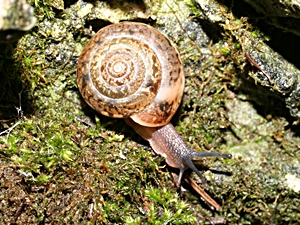 Large leaf snail (Euomphalia strigella). |
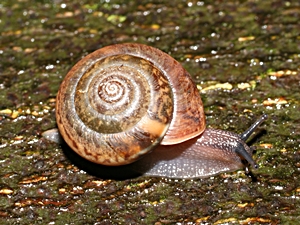 Photos: © Alexander Mrkvicka, Vienna. |
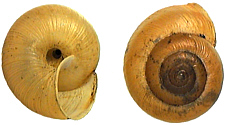 Euomphalia strigella. Photo: Helmut Nisters. |
Description: The large leaf snail has got a depressed conical shell, the colour of which can range grom yellowish gray to horn brown. The shell surface is striped and ribbed, and in juvenile specimens it can be covered in hairs. The shell's whorls are rounded, the apertural rim is widened with a whitish lip. The shell navel (umbilicus) is wide, taking about 1/5 of the shell's overall diameter (more than in Fruticicola fruticum and noticeably more than e.g. in Monacha cantiana).
The literal translation of this snail's genus name means "with a well-shaped navel".
The snail's body is yellowish gray to reddish brown with small black spots that are visible through the shell wall. The snail's tentacles are darker and of grayish colour. The snail moves slowly, is easily scared and secretes lots of mucus when disturbed.
Dimensions: W: 13 - 18 mm; H: 8 - 12 mm; N: 5¼ -
5½.

Habitat and Distribution: The large leaf snail is a ground-dwelling snail living in open forests, bushes and on semi-dry grassland. Its area of distribution spreads over East and Central Europe, from southern Scandinavia and northern Russia, through central France as far as the Pyrenees, as well as in the North of Italy. In Switzerland and Bulgaria, this species can be found in elevations of up to 1600 m MSL.
Euomphalia strigella is a potential intermediate host of the lesser liver fluke (Dicrocoelium lanceolatum).
Threat Situation: The large leaf snail is threatened by habitat
destruction in parts of its distribution area. So, for example in Upper Austria
and Salzburg, the species is threatened by extinction. In Lower Saxony and
Rhineland-Palatinate, it is threatened, in Bavaria it is receding and in the
rest of Germany, Austria and Switzerland, it is near threatened (![]() Threat categories according to IUCN
Red List).
Threat categories according to IUCN
Red List).
Links
Girdled Snail - Hygromia cinctella (Draparnaud 1801)
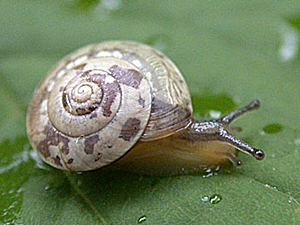 Girdled snail (Hygromia cinctella). Photo: © Stefan Haller, (schneckenfoto.ch). |
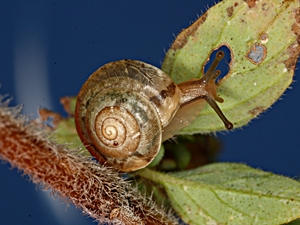 Girdled snail (Hygromia cinctella). Photo: © Alexander Mrkvicka, Vienna. |
Description: The shell of Hygromia cinctella is thin walled and depressed conical. It has a whitish gray to horn-brown colour, and its surface is structured with diminishing stripes. The last whorl is sharply keeled with a whitish keel stripe. The apertural rim is only little extended, the navel is very narrow and almost completely covered by the columellar lip. The snail is slender, light yellowish gray with a darker head and tentacles.
Dimensions: W: 10 - 12 mm; H: 6 - 7 mm, N: 5 - 6.

Habitat and Distribution: The girdled snail lives in low bushes and fresh herb vegetation, often also alongside creeks. In Switzerland it almost exclusively lives in man-made habitats, in gardens on herbs and bushes, more rarely in natural forest, in elevations of up to 900 m MSL. In England the snail is to be found in between grass, nettles, ivy, umbellifers and similar plants, near roadsides, on stone walls and in gardens.
The species' distributions area spreads from southern France as far as southwestern Switzerland, Italy and northwestern Yugoslavia. It was introduced to England (Devon and Worcestershire), Austria (near Vienna) and to Hungary (Budapest), as well as to the USA (Georgia).
Links
Shadow Snail - Urticicola umbrosus (C.Pfeiffer 1801)
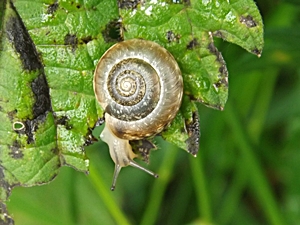 Shadow snail (Urticicola umbrosus). Photo: Robert Nordsieck. |
 Shadow snail (Urticola umbrosus): Lobau, Vienna, Austria. Photo: Karen Andrea Boehme (iNaturalist). |
Description: The shadow snail has got a strongly depressed thin-walled shell, which is finely striped, sparsely covered in hairs. Especially in its weathered state the shell surface is characteristically granulated (well recognizable under a magnifying glass with six times magnification, an important difference to similar species). The shell has a pale yellowish gray to reddish brown colour; through the thin shell wall the pattern of the mantle is often visible.
 Urticicola umbrosus, view of the umbilicus. Photo: Christine Hecher (iNaturalist): Schladming, Austria. |
The apertural lip is weakly developed, the shell navel (umbilicus) is wide and perspective.
The literal translation of this snail's genus name means "living on nettles".
Dimensions: W: 12 mm; H: 6 mm; N: 5.

Habitat and Distribution: The shadow snail lives on the ground, under dead leaves in the herb and bush vegetation of humid forests. Its ditribution area spreads from western Ukraine past the northern Carpathians and the Polish Jura as far as the eastern German low mountain ranges, the eastern Alps and the Alpine foothills. Its western borders lie in the eastern Franconian Jura, in Upper Swabia, the Tyrolian Inn Valley and in the South in Bosnia.
Links
Ciliate Snail - Ciliella ciliata (Hartmann 1821)
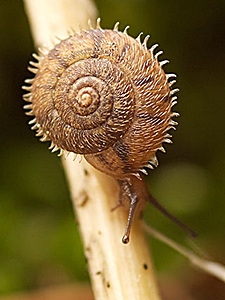 Ciliate snail (Ciliella ciliata). Photo: © Stefan Haller, (schneckenfoto.ch). |
 Ciliella ciliata, shell view. Photo: O. Gargominy (Source). |
Description: The ciliate snail has got a brownish flattened shell
with a conical upper side and a rounded underside. The whorls are sharply keeled
at their outer line. The apertural lip is simple, sharp and folded. The narrow,
but open, shell navel (umbilicus) partly is covered by the apertural lip.

Ciliate snail (Ciliella ciliata): Bergamo, Italy.
Photo:
Fausto (iNaturalist).

Ciliella ciliata: Encamp, Andorra.
Photo:
Óscar Mendez (iNaturalist).
Special mention should be given to the ciliate tips made from the shell skin (periostracum) along the keel, which give the snail a certain superficial resemblance to a spiny Acanthinula (Acanthinula aculeata, Valloniidae), which, however, is noticeably smaller.
Dimensions: H: 4 - 6 mm; W: 9 - 12 mm.

Habitat and Distribution: Ciliate snails occur on humid, grass-covered hillside slopes, alongside creeks and on slopes in mountainous country, on Alpine meadows as well as in the herb vegetation of forest. More rarely the species can also be found in gardens and parks. In the Alps, the ciliate snail is found in elevations up to 2100 m MSL.
The distribution area of Ciliella ciliata spreads over the western and southern Alps, in the South as far as the Tuscan Apennine mountains, in the East as far as the Tagliamento River in Friuli and to southern Carinthia. In isolated populations the species also occurs in the eastern Pyrenees.
Links
 With photos by Stefan Haller: http://www.schneckenfoto.ch. |
Latest Change: 28.09.2025 (Robert Nordsieck).